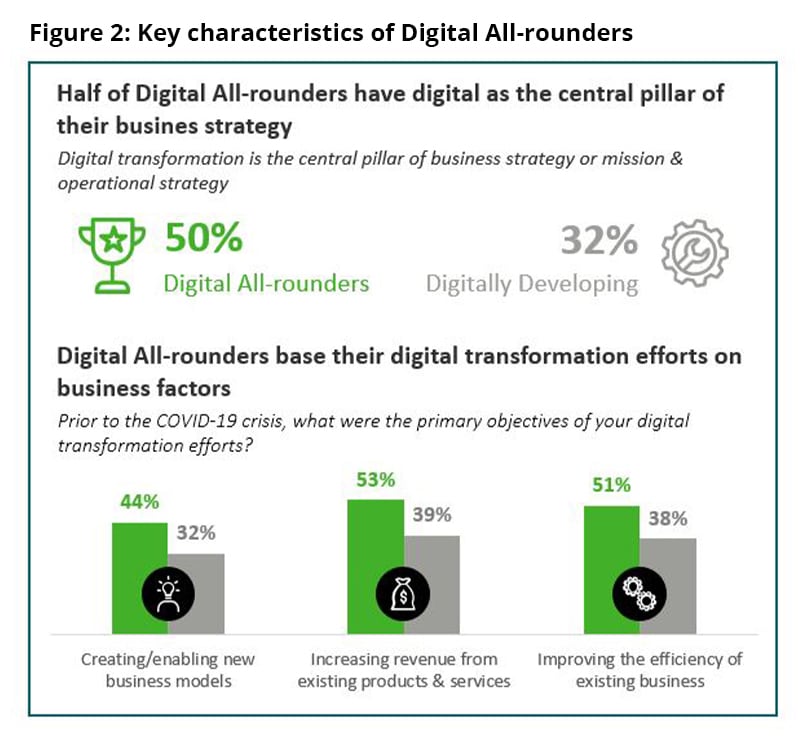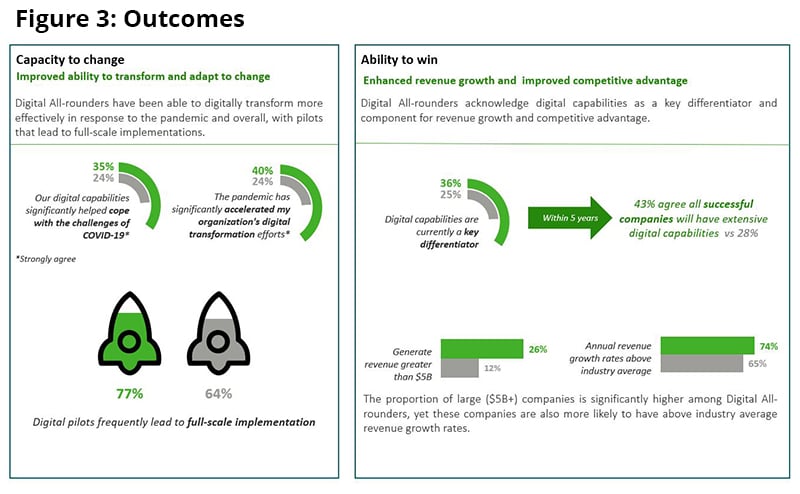Ability to win and capacity to change to survive and thrive | Deloitte US has been saved
A blog post by Diana Kearns-Manolatos, senior manager, Center for Integrated Research, Deloitte Services LP and Jay Bhavesh Parekh, Senior Analyst, Center for Integrated Research, Deloitte SVCS India Pvt Ltd.
In our recent Deloitte Insights research, “A new language for digital transformation,” we assert that digital is a means to an end, not an end in itself. It involves understanding change across the industry and organization as well as how to harness that change for competitive advantage—and, most critically, how to enable that advantage with technology to win. Digital transformation is the ability to adopt or apply technology to constantly evolve and reinvent to support an overarching business strategy and to achieve transformative change. A digital strategy that factors these five digital imperatives—experiences, insights, platforms, connectivity, and integrity—can enable organizations to more effectively digitally transform.
Five digital imperatives to enable ability to win and capacity to change
Businesses need to orient themselves along the two dimensions of ability to win and capacity to change to navigate a less predictable, increasingly complex, and rapidly changing operating environment that traditional transformation initiatives (e.g., modernization, optimization) alone cannot keep up.
- An ability to win refers to an organization’s long-term strategic vision and goals supported by distinctive assets and capabilities that retain value in various future scenarios.
- A capacity to change refers to the operating model, capabilities, and leadership that allow the business to rapidly and flexibly adapt how it positions, delivers, and monetizes its ability to win.
Our analysis of data from 2,860 global business and public-sector leaders responding to Deloitte’s 2021 Digital Transformation Executive Survey[1] has shown that increased adoption of these five digital imperatives correlates with greater success at achieving digital transformation maturity[2] as well as the strategic enterprise objectives of ability to win and capacity to change (figure 1).[3]

While approximately 67% of survey respondents have embraced at least one digital imperative, it is by combining them in an integrated digital strategy that organizations really begin to see greater value. In fact, the data showed that the number of digital imperatives an organization has adopted has a correlation with its digital maturity. However, the number of organizations that are successfully combining all five digital imperatives is still few and far between (only 31 survey respondents fall into this category).
Therefore, to more effectively gauge the value that organizations can gain from increased adoption of the digital imperatives, we created two personas:[4]
- Digital All-rounders represent those organizations who have implemented three or more digital imperatives and represent approximately 13% of respondents.
- Digitally Developing represent those who have implemented fewer than three digital imperatives, comprising the majority with 87% of respondents.
Deep diving into the Digital All-rounder
Our analysis found that Digital All-rounders place digital transformation at the center of their business strategy (50% versus 32% among Digitally Developing) to enable new business models, increase product and service revenue, and improve business efficiency. Consequently, business factors play an important role in defining digital transformation objectives (figure 2). These are supported by higher sustained financial commitments toward digital initiatives.

This results in an organization that is more adaptive to change with the ability to cope with any disruption or crisis. The pandemic showcased how All-rounders were more likely to use disruption to their advantage by further accelerating their digital efforts (40% versus 24% among Digitally Developing).
Benefits of becoming a Digital All-rounder
More Digital All-rounders acknowledge digital capabilities as a key differentiator and are cognizant of the role they will play in transforming and adapting to change, maintaining a competitive advantage, and ensuring success (figure 3).
- Digital All-rounders have potentially been able to respond to the pandemic with what appear to be more successful Digital Transformation initiatives in terms of outcomes achieved. Thirty-five percent of Digital All-rounders said their digital capabilities significantly helped them deal with the challenges of COVID-19 versus 24% among Digitally Developing.
- Hence, they seem to be more active in frequently launching new digital pilots and scaling them up to full implementations (77% versus 64% among Digitally Developing) and using digital capabilities as a key differentiator (36% versus 25% among Digitally Developing).
- Despite a higher proportion of large companies with revenues of more than $5 billion, Digital All-rounders are typically more successful in achieving revenue growth rates that are above industry average (74% versus 65% among Digitally Developing).

Rise of the 21st-century enterprise
As the data shows, most organizations are still early in their digital transformation journey when it comes to thinking about these digital imperatives. Many are still Digitally Developing and still exploring how to bring together the different elements of strategy and technology and can benefit from this common language to accelerate their thinking and implementation. That said, the advantages derived by Digital All-rounders through their ability to win and capacity to change showcase the importance of these dimensions to yield market positioning and valuation and are better placed to future-proof their businesses from disruptive forces and marketplace shifts.
[1] Analysis of data from a survey of 2,860 executives and public-sector leaders from seven countries, conducted by KS&R Inc. in November 2020 and January and February 2021, for the 2021 Deloitte Digital Transformation Executive Survey in the Putting digital at the heart of strategy report.
[2] We define “digital transformation success” as the ability to successfully deliver the digital transformation program aligned to the business strategy. This differs from “digital maturity,” which is defined in the first annual digital transformation survey report, Pivoting to digital maturity.
[3] A particular organization is considered to be embracing a particular digital imperative based on its past commitments toward that imperative, the present impact they are witnessing from it, and their future perception about the enabling technologies.
[4] While successfully implementing all five digital imperatives is the ultimate goal, currently only a small minority (31 respondents) have transformed using all five, making this the preferred methodology for analysis.
Get in touch

David Linthicum
As the chief cloud strategy officer for Deloitte Consulting LLP, David is responsible for building innovative technologies that help clients operate more efficiently while delivering strategies that enable them to disrupt their markets. David is widely respected as a visionary in cloud computing—he was recently named the number one cloud influencer in a report by Apollo Research. For more than 20 years, he has inspired corporations and start-ups to innovate and use resources more productively. As the author of more than 13 books and 5,000 articles, David’s thought leadership has appeared in InfoWorld, Wall...

